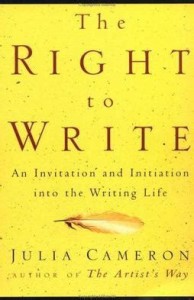I’m preparing to teach a workshop on creativity, so have been scavenging in my bookshelves for relevant books. In this book, subtitled An Invitation and Initiation Into the Writing Life, Julia Cameron asserts that everyone can lead a creative life.
She makes it easy for the reader to take one small step after another by having brief essays—the invitation—followed by an exercise—the initiation. With each essay, she follows her own advice of starting where you are. She may describe the scene outside her window, something that happened earlier that’s on her mind, or simply an idea.
For example, one essay starts: “Much ado is frequently made about writers and their rituals.” She goes on to talk about special pens, phones silenced, etc. before saying, “I don’t like to make such a big deal about writing.”
Thus, the essays are entirely accessible. The exercises that follow are simple to do, but help the writer dig into themselves and find the will and confidence to write. In addition to the “self-cherishing” and self-discovery sections, there are practical suggestions for living a creative life.
For example, she talks about how writing is actually physical work—“an embodied experience.” She describes writing through the body and suggests a walk, possibly taking along a specific question or topic, and then writing about your experience when you get home. I also like her discussion of writing as being not a monologue but a conversation between the writer and reality. From there she talks about the need to pay attention and closely observe what’s going on around us.
In addition to the essays and exercises, Cameron deploys the two main tools she debuted in her bestselling workbook The Artist’s Way: Morning Pages and Artist Dates.
For Morning Pages, she tells us to write three pages longhand, first thing every morning. What you put down can be about anything; just keep writing. These serve a number of purposes, such as getting you used to writing on the spur of the moment, setting aside your inner censor, and accessing deeper levels of consciousness: “dropping into the well.”
For Artist Dates, she recommends scheduling a play date with your inner artist. This could be a visit to a museum, a film, a walk in the woods: whatever feeds your creativity. Art is process, and the process is supposed to be fun.
The book is a response to people like the Great Writer who over dinner complained to her that too many people were calling themselves writers without having suffered enough, without having come up the hard way, and “‘all that slush keeps the good writers from being published. Writing isn’t for amateurs.’”
Cameron’s response is that too many beautiful voices have been silenced, either by mockery or poverty or some other “creative accident.” She wants everyone’s voice to be heard.
I agree. Just as it’s uncommon today for families and friends to gather around a piano for a sing-song, believing instead that singing is for professionals, many people in our time think that in order to write you have to be a Great Writer—though how one is recognised as such is a minefield—whereas in the past everyone who could wrote letters, diaries, poems, etc. I want to hear those stories, the ones that are buried. That’s why I call my memoir classes Sharing Our Stories.
In another of her books, The Sound of Paper, Cameron reminds us of our purpose as writers:
We say the unsayable and in saying it we name not only ourselves but also the human condition. By being willing to characterize our lives in art, we begin to have the character necessary to make living itself an art.
Do you think that creative writing is for everyone or just for a select few?

